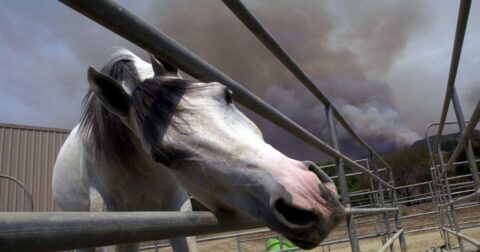Reported
The U.S. Wants to Cut Food Waste in Half. We’re Not Even Close
Climate•5 min read
Explainer
A look at the impact of fires in California, and beyond.



Words by Grace Hussain
January’s Los Angeles fires set ablaze over 35,000 acres. Last year and a couple of states away in Texas, the Smokehouse Creek fires impacted over one million acres. Fires of this magnitude devastate homes and entire neighborhoods — but humans aren’t their only victims. A range of animals are also significantly impacted by fires, but often lack proper support systems.
Let’s take a look at how wildfires affect animals, and how climate change and other human actions might be making matters worse.
As the climate shifts and temperatures creep upwards, fires are getting more severe. That’s because as the climate becomes warmer and drier, fire seasons — the parts of the year most suited to fires — are getting longer.
However, climate change is not the only factor contributing to the megafires that have become increasingly common over the last few years, Tiffany Yap, PhD, a scientist with the Center for Biological Diversity’s Urban Wildlands Program, tells Sentient. In California, for example, urban and suburban development also plays a role.
The Los Angeles fires aren’t forest fires; they’re taking place in what are called chaparral ecosystems — landscapes made up of low-lying shrubs and other vegetation. Usually chaparrals burn every few decades, but because they’re being developed, they’re burning more frequently. “We’re putting more development in these chaparral areas, and that increases ignition risk,” says Yap. “Fires are being caused by power lines, electrical equipment, arson, fireworks, car sparks — and so these chaparral areas are burning more regularly than they used to.”
Agriculture is another factor that encourages the proliferation of fires. Non-native grasses, many of which were introduced to feed livestock, often burn faster and hotter than native species, allowing fires to spread more quickly.
In California, agricultural water usage has exacerbated the problem. The state is the country’s largest dairy producer, home to around 1,000 dairy farms and 1.7 million dairy cattle. Collectively, those farms use 142 million gallons of water daily. Lots of grass has to be grown to feed all those cows — alfalfa feed crops use 16 percent of California’s water supply according to a 2021 Food and Water Watch report — thereby compounding fire risk. Almond and pistachio crops, which were the second “thirstiest” crop, used less than alfalfa.
The state’s water issues are slated to get worse, with wild animals bearing the brunt of the impact. Unfortunately, some wild animals are also being unfairly blamed for the fires.
In an executive order this month titled “Putting people over fish: Stopping radical environmentalism to provide water to southern California” President Trump instructed agencies to reallocate water from Northern to Southern California. Until now, that water has been an essential habitat for Delta smelt, a type of fish. The move fulfills promises he made to farmers in 2016 about increasing their water supply. But according to experts, California’s policy to retain water as Delta smelt habitat is not causing a water shortage in Los Angeles, contrary to Trump’s assertions.
Contrary to Trump’s statements and misinformation circulating online, there was more than enough water available to firefighters. But as reported by NPR, firefighters had to rely on existing municipal water infrastructure, which was not designed to tackle wildfires of this scope and intensity.
Though it’s hard to know how many animals die each year from wildfires, even one major event can devastate populations of animals for years to come.
For example, in 2020, fires swept through 11 million acres of the Pantanal wetland. Based upon walkthroughs performed after the fact, researchers believe in excess of 17 million animals died — a number they say is conservative.
That same year, more than 28 million acres in Australia burned, killing an estimated three billion wild animals. The images of the aftermath were gruesome, featuring koalas, kangaroos and other native species with obvious burn injuries, and other animals standing amongst the charred remains of once-lush habitat.
If a fire doesn’t directly kill an animal, the aftermath of it can. In California, Yap tells the story of a mountain lion in 2018 fleeing the Santa Monica fires, only to come up against human development, leading the animal to turn back into the flames. Later, they found the large cat dead from starvation with severely burnt paws, says Yap.
While fires don’t spare any species of animals, some have greater protections than others. After Hurricane Katrina impacted New Orleans, it became clear that providing emergency relief also means helping people care for their pets. Congress passed the PETS Act, which allows FEMA to provide emergency relief to household pets and service animals as part of their program.
The Animal Welfare Act also provides protections for some animals in the face of a disaster. The Act “requires emergency preparedness plans, evacuation plans for animal breeders, animal exhibitors, and animal research facilities,” says Delci Winders, who leads Vermont Law and Graduate School’s Animal Law and Policy Institute. “It excludes farmed animals, so they don’t have those protections,” she continues. Their lack of protections are made worse by indemnity programs that pay farmers for animals killed by a disaster.
The livestock indemnity program only pays farmers 75 percent of each animal’s value, meaning farmers would stand to make more money if the animals survived. But that calculus changes when you add in the cost of evacuation. Once you build in the price of evacuation, it becomes economically beneficial for producers to leave their animals to die in natural disasters, creating perverse incentives.
One of the major problems is the scale of factory farms. “When you’ve got such a massive number of animals, as we do now in industrial animal agriculture facilities, it’s very hard to have a plan in place as to what to do with those animals,” says Winders, pointing specifically to transportation as an issue. For example, to be considered a large concentrated animal feeding operation, the legal term for a factory farm, a farm needs to have 1,000 cattle. Moving that many animals on short notice in the face of a fire proves challenging.
Wildfires occur naturally, and are often good for environments and animals, points out Yap. “A lot of species are adapted to wildfire. They’re resilient to wildfire. Sometimes they even need wildfire to survive,” she says.
The problem is, the fires are changing. Unlike the megafires we’re seeing now, historically, a fire leaves behind a mosaic of different impacts, says Yap. Traditionally, during a fire, some areas are completely burned out, and then make an ideal habitat for woodpeckers and different insects. An adjacent section of the impacted ecosystem might have only been subjected to moderate burning, or just had low lying brush burned out.
“But when an entire area burns severely, that can be pretty concerning,” says Yap. “Some severity can be beneficial. A lot of severity can be harmful.”
Fires are part of a healthy ecosystem, but they’re getting bigger and hotter — a trend that puts animals across species at risk. Human activity, such as agricultural water usage and development, is increasing the severity and intensity of fires. Many animals lack any form of meaningful policy protection from fires, while segmented habitats make escape difficult, if not impossible.
“We should be challenging all these things that are being done [at the federal level],” says Winders. “But we also need to be proactive at the state, state and local level, and honestly, at the personal level as well. People can make a personal choice not to eat food that are massive contributors to climate change, primarily meat and dairy, but also, we can push [California] to stop subsidizing these industries that are creating climate change, exacerbating climate change, exacerbating the fires and exacerbating the water situation.”
An earlier version of this story was published September 29, 2023.